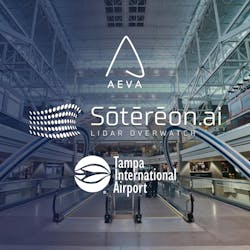Tampa International Airport and Sotereon.AI Deploy Aeva 4D LiDAR to Enhance Airport Safety
Aeva announced that Sotereon.AI (formerly The Indoor Lab) has begun deploying Aeva’s 4D LiDAR technology at Tampa International Airport (TPA) as part of a transformative initiative to optimize airport operations, enhance public safety and security, and improve the passenger travel experience across the airport environment.
The deployment is part of Sotereon.AI’s broader mission to bring advanced spatial intelligence with its Overwatch analytics software platform to major U.S. airports and transit hubs using LiDAR technology. With Aeva’s FMCW (frequency modulated continuous wave) 4D LiDAR sensors, TPA is now able to capture rich real-time data and long-range perception across a variety of critical use cases—enabling a proactive, data-driven approach to operations and security.
“By combining Aeva’s world-class 4D LiDAR-on-chip technology with our leading spatial intelligence platform, we’re delivering insights to infrastructure operators that weren’t possible before,” said Patrick Blattner, CEO and co-founder of Sotereon.AI. “Whether it’s securing our airports, optimizing vehicle and passenger traffic flow, or tracking tarmac operations, we now have a more comprehensive live operational view that allows airport stakeholders to make faster, smarter decisions.”
Key possible use cases for Aeva’s 4D LiDAR at Tampa International Airport include:
-
Intelligent Infrastructure Management: Airport infrastructure safety, including parking infrastructure safety and security, including unauthorized access monitoring, theft, and early detection of vehicle smoke and fire. Additionally, real-time traffic management on airport roads can help to improve congestion and optimize vehicle traffic flows.
-
Passenger Monitoring and Security: Leveraging 4D LiDAR data, the Overwatch intelligence platform has the potential to help airport operations and security teams monitor safety incidents within airports and improve passenger safety and emergency responses. Additional use cases may include, among others, threat detection at checkpoints and tracking of bags associated with traveling passengers.
-
Airside and Tarmac Operations: Vehicle and equipment monitoring and tracking on the tarmac, utilizing LiDAR vehicle and object classification software. Detection and monitoring of safety hazards such as personnel in proximity to restricted safety zones around jet engines and other areas.
“Aeva’s mission is to bring the next wave of perception to the physical world—and Tampa International Airport is another leading example of what’s possible with our flexible technology platform,” said James Byun, Managing Director of Business Development at Aeva. “Together with Sotereon.AI, we’re showing how real-time 4D spatial data can power safer, more efficient, and more intelligent airport environments.”
This deployment at TPA builds on previous deployments with Sotereon.AI at some of the nation’s largest and most heavily trafficked airports, including John F. Kennedy International Airport’s New Terminal One.
